Human-flamingos, queer pokemons and other unique creatures at the BioFeral camp in Crete
Published 26 October 2024 by Lyn Hagan
The latest camp in the BioFeral.BeachCamp series of Ionian University’s Taboo-Transgression-Transcendence program was held in Crete at the end of September. Lyn Hagan immerses us in the queer world of the organizers and participants of this decidedly feral lab.
TTTlabs BioFeral.BeachCamp III: NewRepro-FlaOctomingopus – Non-Human Bioart/Bodyart on the Beach (BFBC NR-FO NB-BB) took place from September 15-25th 2024 in Athens School of Fine Arts’ Annex of Rethymno in the island of Crete, Greece. It was the final part of a trilogy of art camps conceived and led by bio artist Adam Zaretsky and Professor Dalila Honorato from Ionian University, who also organises the TTT conferences (Taboo – Transgression – Transcendence in Art & Science) as well as FEMeeting: Women in Art, Science and Technology.
This BioFeral Beach Camp threw a speculative thematic framework around research looking at new forms of reproduction, both human and non-human, artificial wombs, assisted and natural implantation, queer ecology and artificial intelligence. The selected and invited participants (16 on site and 5 online) interrogated these ideas through the prisms of their own practice and were drawn from the fields of bio-art, performance art, sculpture, science communication, microbiology, literature, curation, though it was difficult sometimes to know where these boundaries were as there was substantial overflow between methods and ideas.
The theme of implantation was fitting as some artists took to the environment and ethos of the camp, whilst others found it a difficult environment within which to make work, or even talk about their practice in. There were strong personalities within the group, many different sexualities, genders, ages, races but feminist, Marxist and post-human philosophies dominated with words like ‘entanglements’ and ‘making kin’ proliferating in both the form and terminology of the performances and presentations that took place. Over the first days, people began to share their experiences and perspectives over dinner, especially those from the Global South about their migrant status in other countries, about white supremacy, politics, queerness, murders in the family and of course, Palestine. Again, it was sometimes difficult to know where boundaries lay and conversation occasionally got messy and piqued.
A Speculative Union of Flamingo, Urchin, and Rice
Trying to establish the impact of live research performances on its audience is difficult but when everyone gets out a camera and starts taking photos and filming, that is often a good indication. Kristin Lucas (USA) and Nathalie Dubois Calero (Canada) collaborative performance ‘Stamping Genes: A Speculative Union of Flamingo, Urchin, and Rice’ was a radical act of symbiosis between both artist’s work and research. Kristin has been interrogating the idea of the double in her practice for many years and in her performative framing of flamingo conservation, this double is non-human. Nathalie brought her training as a scientist and knowledge of non-human and human microbiomes, and the viruses in our DNA. Together these forms of knowledge and practice were twinned in a speculative performance where Kristin, dressed as a human-flamingo underwent a ritualistic transformation through an experimental IVF implantation of sea urchin microbiota and genes through sperm release, using rice as a biological interface between flamingos, humans and sea urchins. The scene ended with the sounds of sea urchins and flamingos echoing through a transformed ecological landscape, designed to signify the preservation and continuation of this new evolutionary form.
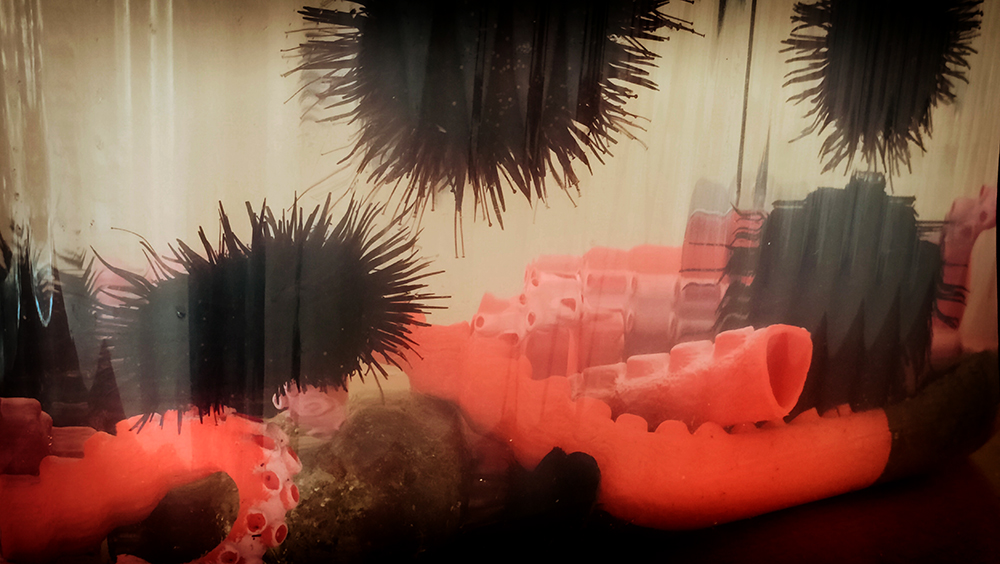
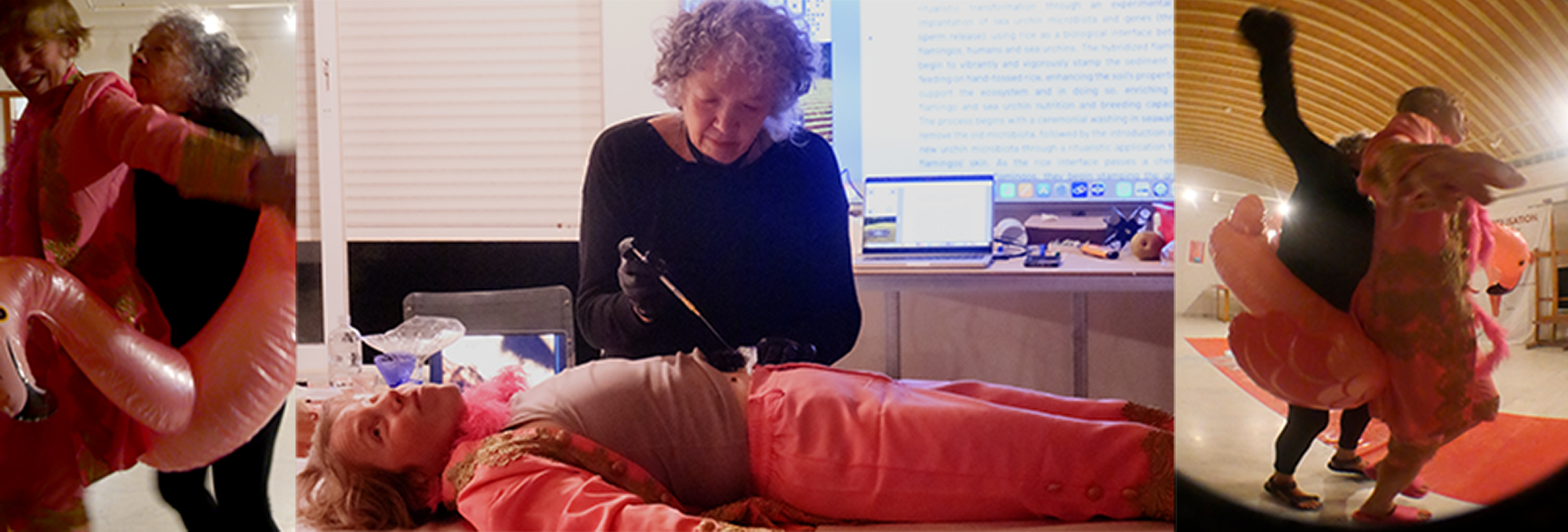
Chiara Pitrola (Netherlands) performed a new iteration of her hydration liturgies series ‘Trancecorporeal’, surrounded by half-made small stone sculptures that littered the beautiful setting under the arch of the main building where still humans also gathered to be shaded from the sun. Audience members sat in a circle whilst self-declared hydro-feminist Chiara played a soundscape she has made and handed out ice as part of her pleasure activism. This performance towards the end of the 10 days together, was sensuous in its delivery and content and worked, perhaps unintentionally, to bring the group together in an encounter that allowed for a pause in activities, and relaxation.
Designing Pokemons in a Virtual Queer Environment
Isidora (Ipi) Paz Fernandez (Chile) gave a talk on queer ecology and led a workshop to get the participants actively embracing the Pokemon as a queer ecological being. People were paired together in a Virtual Queer Environment to design a creature using the following parameters: species, queer behaviours, reproduction style and tasked with creating an image using AI, along with its superpowers. She closed the session with projecting her own creation onto her stomach, though my favourite just because of its name, was Elton Fly John created by Praba Pillar (USA) and Janet Sarson (USA). Their final performance revolved around a kind of multi-tiered form of embrace. They embraced each other whilst performing ‘Cicada Panoramas’ which explored the dirty art of symbiotic non-human queer mothering and enrichment, emerging like the cicadas they gathered the husks of, writhing to a background soundtrack of A.I./human embrace.
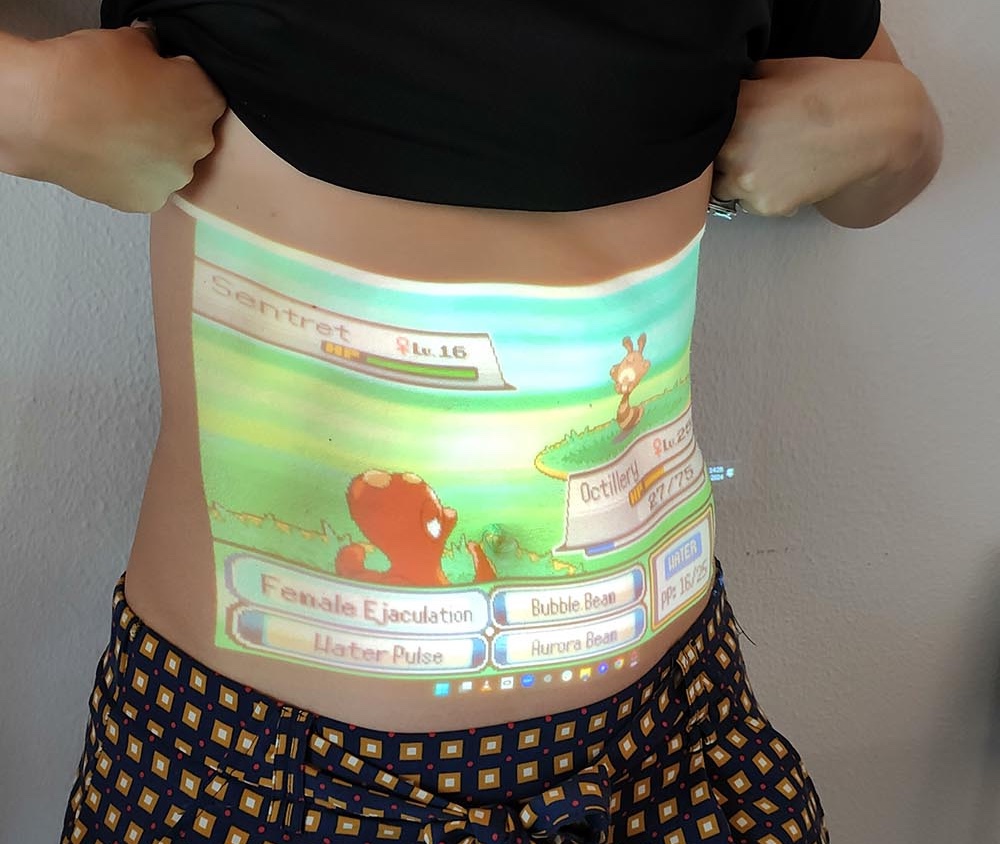
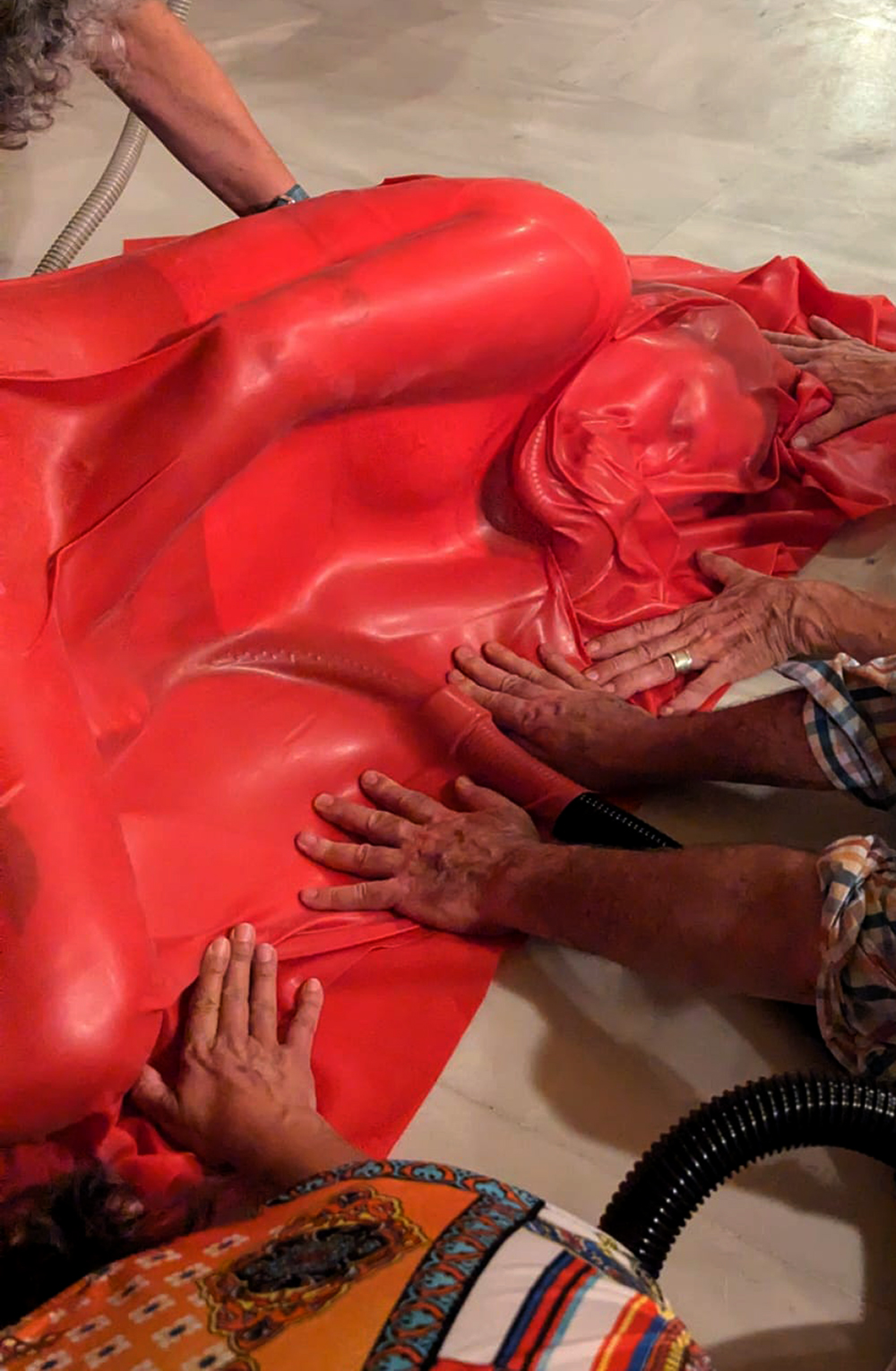
Ivana Tkalčić (Croatia) showed us her accelerationist video work that tapped into the information overload of our current times, followed by documentation from her time taking part in Astronaut training as part of the European Space Agency program, inspired by her countries decision to launch a space agency. She explained the uncomfortable nature of being in such close restrictive confines with others and deglamourized the often hyped-up space migration sci-fi stories familiar from the hippy-Utopian dreams of yesteryear and contemporary techno feudal lullabies like those from Musk et al.
Online fellows Xristina Sarli (Germany) and Augusto Calçada (Brazil) from Terrabytes Glitch Lab worked tirelessly in the background to make a live virtual environment in tandem with the proceedings and the participants were given characters based on questionnaires they voluntarily answered.
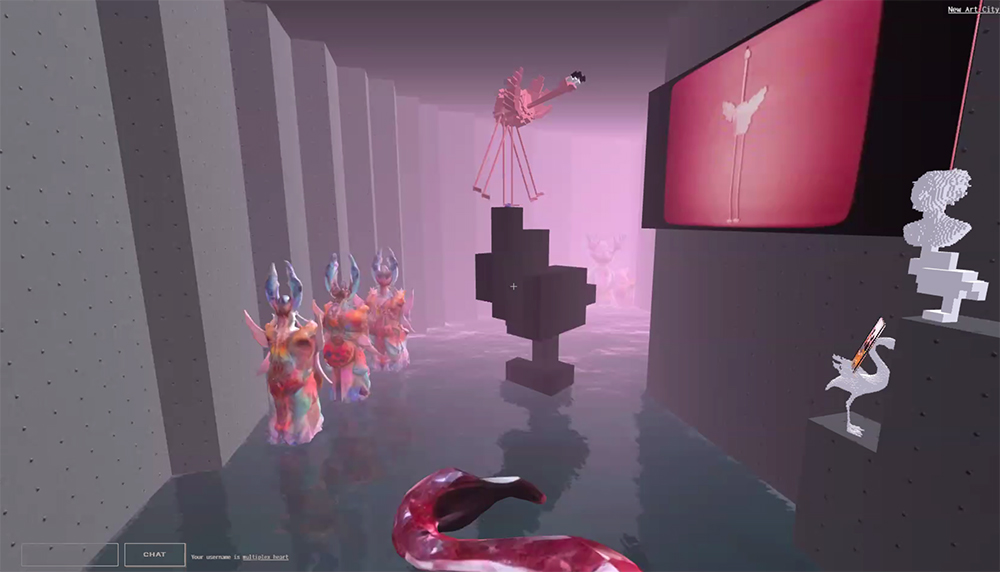
Biomaterials: fingernails, skin flakes, saliva, hair, sperm, metal scraps, flower petals and general donated human/other viscera
Nafsika Tzanoulinou (Greece) and Nikolas Marcellos (Greece), both students at the prestigious Athens School of Fine Art, drew upon more traditional mediums like drawing and sculpture. Both added a bioart/ecological twist with Nafsika asking participants to add body parts to her sculpture (hair, nails, saliva and contentiously, an unsolicited donation of semen – see banner image) were incorporated whilst Nikolas got participants to draw with found materials from the natural environment and ink in a collaborative drawing. Hailing from Ionian University came students Viktoria (Tori) Koniaeva (Greece) and Serafeim (Sera) Marathias (Greece) Tori was our informal expert on languages and insects, cooked breakfast and dinner throughout TTTlabs, presented her proposal for an international database for the unrecognised deaths of domestic violence in the gay and trans communities and gave Tarot readings to whose who wished towards the end of the time together. Documentary film maker Sera captured all the camp activities and interviewed its participants and will release a film that I look forward to seeing.
Malaika Kinyua (France) gave a talk about her experiences as a person from Reunion Island, a French-governed island in East Africa, and her speculative project to make human leather from her own skin. She narrated how the women of her island were subject to forced sterilisation procedures which led to discourse about the often uncomfortable overlap between active and passive forms of genocide, spilling into discussion on the rise of the Far-Right in Europe and the increased use of neo-eugenic technologies. The idea of sanitisation of the human has not gone away, it merely changes forms, uses new terminologies and technologies. These conversations around race and colonialisation were continued through the prism of their own experiences by Chinedum Muotto (Ireland) and Nupur Doshi (India). Nupur presented a workshop on the concepts of positive and negative expectations of the future based on issues of who is perceived as beholding power which brought in a discussion on curatorial work and representations of cultures whilst Praba Pilar (USA) and Brian Contreiras (Guatemala) underlined discrimination based on ethnicity and social-economic factors. From the first day on a walk in the local hills with Dalila, these reflections on collection, preservation, protection and legacy circulated and Chinedum as well as Praba and Ipi had amazing volunteer contributions. Mellissa Monsoon (UK) also visited to do a workshop and skill share with clay.
Lab visits in Heraklion
The highlight for many were the visits arranged by Adam and Dalila to Crete Fertility Centre IVF Clinic and FORTH (Foundation for Research and Technology) labs. We were received at the entrance of the Institute of Molecular Biology and Biotechnology main building, by Mrs. Christiana Divini, Head of the International and Public Relations Dpt and IMBB Director, Prof. John Vontas. There was a lecture by Dr. Anastasios Pavlopoulos, Group leader at Developmental Morphogenesis Lab/Institute of Molecular Biology and Biotechnology followed by a lab tour to the Systems Neuroscience lab, Molecular Entomology / Pesticide lab, Regenerative Pharmacology and Human Genetics & Precision Medicine. Adam and Dalila also arranged a visit to the interesting geological sea site of Preveli, near the Moni Preveli Monastery. Here was a place where the river met the sea, and the group again got an opportunity to relax before the excitement of Ipi and Tori having found an underground cave on their swim.
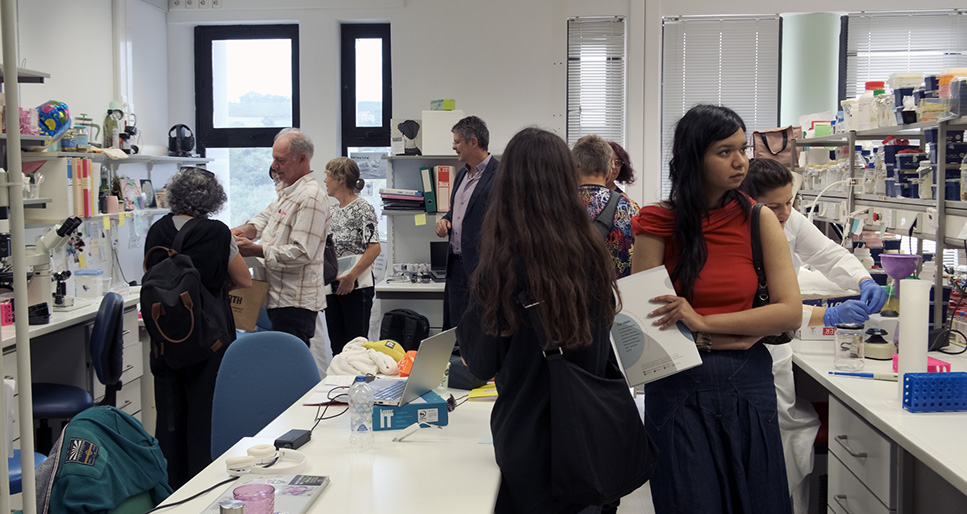
The story of TTTlabs III for me was one of chance encounters, each of which had its own complexities and rewards but the underlying question that is raised, and not anew, is one of human and non-human autonomy and dignity. As long as another creature, whether it meets your criteria of sentience, agency, value or not, is subject to the laws of property over those of dignity, permission is given to take that body as material fit for purpose whatever that may be. The desire to mediate the forces of power seems to be dependent upon the ability to advocate or provide testimony – to be blunt to have a voice or be ventriloquised for by others. The unseen, unheard, vulnerable subject even then is subject to further politicisation and appropriation, the weaponization of its unknown or disregarded pleasure-pain vortex, its ontological in betweenness in between recognised life and death.
The BioFeral.BeachCamp series is part of Rewilding Cultures, a program co-funded by the European Union.
